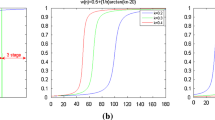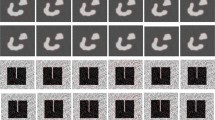Abstract
Images with intensity inhomogeneity and blurred boundaries are common in image segmentation tasks, which inevitably result in many difficulties in accurate image segmentation. Massive active contour models (ACMs) have been proposed to solve the problems of intensity inhomogeneity or blurred boundaries respectively. However, there is almost no way to effectively solve the above two problems at the same time, and they are sensitive to the initial contour and noise, or their segmentation speed is relatively slow. In this paper, we propose an active contour model (ACM) based on adaptively variable exponent combining Legendre polynomial (LP) for image segmentation. First, the Legendre polynomial intensity (LPI) is defined, which employs a linear combination of Legendre basis functions for region intensity approximation. Second, an adaptively LPI term is defined, which adopts an adaptively variable exponent function as an acceleration term to drive the curve to quickly evolve to the object boundaries. Third, the distance regularization term is introduced into the active contour as a regularization term to eliminate the need for reinitialization and restrict the behavior of level set function (LSF). Experimental results show that our method offers robustness to gray unevenness, noise and initial curve placement, and adaptability to low contrast and blurred boundaries and outperforms other state-of-the-art algorithms.
















Similar content being viewed by others
Notes
All the computations are implemented with MATLAB R2018a.
Available: https://isic-archive.com/.
References
Abdulrahman AK, Ozturk S (2019) A novel hybrid dct and dwt based robust watermarking algorithm for color images. Multimed Tools Appl 78 (12):17027–17049
Achanta R, Shaji A, Smith K, Lucchi A, Fua P, Susstrunk S (2012) Slic superpixels compared to state-of-the-art superpixel methods. IEEE Trans Pattern Anal Mach Intell 34(11):2274–2282
Bernard O, Friboulet D, Thevenaz P, Unser M (2009) Variational b-spline level-set: A linear filtering approach for fast deformable model evolution. IEEE Trans Image Process 18(6):1179–1191
Cai Q, Liu H, Zhou S, Sun J, Li J (2018) An adaptive-scale active contour model for inhomogeneous image segmentation and bias field estimation. Pattern Recogn 82:79–93
Cárdenes R, de Luis-García R, Bach-Cuadra M (2009) A multidimensional segmentation evaluation for medical image data. Comput Methods Programs Biomed 96(2):108–124
Caselles V, Kimmel R, Sapiro G (1997) Geodesic active contours. Int J Comput Vis 22(1):61–79
Chan TF, Vese LA (2001) Active contours without edges. IEEE Trans Image Process 10(2):266–277
Chen L-C, Zhu Y, Papandreou G, Schroff F, Adam H (2018) Encoder-decoder with atrous separable convolution for semantic image segmentation. In: Proceedings of the European conference on computer vision (ECCV), pp 801–818
Den Bergh MV, Boix X, Roig G, Van Gool L (2015) Seeds: Superpixels extracted via energy-driven sampling. Int J Comput Vis 111(3):298–314
Ding K, Xiao L, Weng G (2017) Active contours driven by region-scalable fitting and optimized laplacian of gaussian energy for image segmentation. Signal Process 134:224–233
Fu J, Liu J, Tian H, Li Y, Bao Y, Fang Z, Lu H (2019) Dual attention network for scene segmentation. In: Proceedings of the IEEE Conference on Computer Vision and Pattern Recognition, pp 3146–3154
Fu J, Liu J, Wang Y, Zhou J, Wang C, Lu H (2019) Stacked deconvolutional network for semantic segmentation. IEEE Trans Image Process
Gao M, Chen H, Zheng S, Fang B (2019) Feature fusion and non-negative matrix factorization based active contours for texture segmentation. Signal Process 159:104–118
Gur S, Wolf L, Golgher L, Blinder P (2019) Unsupervised microvascular image segmentation using an active contours mimicking neural network. In: Proceedings of the IEEE/CVF International Conference on Computer Vision, pp 10722–10731
Hatamizadeh A, Sengupta D, Terzopoulos D (2019) End-to-end deep convolutional active contours for image segmentation. arXiv: Computer Vision and Pattern Recognition
He J, Deng Z, Qiao Y (2019) Dynamic multi-scale filters for semantic segmentation. In: Proceedings of the IEEE International Conference on Computer Vision, pp 3562–3572
Hu F, Zhang M, Chen B (2020) A novel global energy and local energy-based legendre polynomial approximation for image segmentation. Journal of Function Spaces
Lee Y, Park J (2020) Centermask: Real-time anchor-free instance segmentation. In: Proceedings of the IEEE/CVF Conference on Computer Vision and Pattern Recognition, pp 13906–13915
Li C, Huang R, Ding Z, Gatenby JC, Metaxas DN, Gore JC (2011) A level set method for image segmentation in the presence of intensity inhomogeneities with application to mri. IEEE Trans Image Process 20(7):2007–2016
Li C, Xu C, Gui C, Fox MD (2010) Distance regularized level set evolution and its application to image segmentation. IEEE Trans Image Process 19 (12):3243–3254
Li C, Xu C, Gui C, Fox MD (2005) Level set evolution without re-initialization: a new variational formulation. In: 2005 IEEE computer society conference on computer vision and pattern recognition (CVPR’05), vol 1. IEEE, pp 430–436
Liao X, Li K, Zhu X, Liu KJR (2020) Robust detection of image operator chain with two-stream convolutional neural network. IEEE J Sel Top Signal Process 14(5):955–968
Liao X, Yin J, Chen M, Qin Z (2020) Adaptive payload distribution in multiple images steganography based on image texture features. IEEE Transactions on Dependable and Secure Computing
Lin G, Shen C, Van Den Hengel A, Reid I (2016) Efficient piecewise training of deep structured models for semantic segmentation. In: Proceedings of the IEEE conference on computer vision and pattern recognition, pp 3194–3203
Long J, Shelhamer E, Darrell T (2015) Fully convolutional networks for semantic segmentation. In: Proceedings of the IEEE conference on computer vision and pattern recognition, pp 3431–3440
Manogaran G, Varatharajan R, Priyan MK (2018) Hybrid recommendation system for heart disease diagnosis based on multiple kernel learning with adaptive neuro-fuzzy inference system. Multimed Tools Appl 77(4):4379–4399
Marcos D, Tuia D, Kellenberger B, Zhang L, Bai M, Liao R, Urtasun R (2018) Learning deep structured active contours end-to-end. In: Proceedings of the IEEE Conference on Computer Vision and Pattern Recognition, pp 8877–8885
Mencattini A, Rabottino G, Salmeri M, Lojacono R (2010) Assessment of a breast mass identification procedure using an iris detector. IEEE Trans Instrum Meas 59(10):2505–2512
Min H, Jia W, Zhao Y, Zuo W, Ling H, Luo Y (2018) Late: A level-set method based on local approximation of taylor expansion for segmenting intensity inhomogeneous images. IEEE Trans Image Process 27(10):5016–5031
Minaee S, Boykov Y, Porikli F, Plaza A, Kehtarnavaz N, Terzopoulos D (2020) Image segmentation using deep learning: A survey. arXiv:2001.05566
Mishra A, Fieguth P, Clausi DA (2011) Decoupled active contour (dac) for boundary detection. IEEE Trans Pattern Anal Mach Intell 33(2):310–324
Mukherjee S, Acton ST (2015) Region based segmentation in presence of intensity inhomogeneity using legendre polynomials. IEEE Signal Process Lett 22 (3):298–302
Niu S, Chen Q, De Sisternes L, Ji Z, Zhou ZM, Rubin DL (2017) Robust noise region-based active contour model via local similarity factor for image segmentation. Pattern Recogn 61(61):104–119
Peng S, Jiang W, Pi H, Li X, Bao H, Zhou X (2020) Deep snake for real-time instance segmentation. In: Proceedings of the IEEE/CVF Conference on Computer Vision and Pattern Recognition, pp 8533–8542
Pramanik S, Bhattacharjee D, Nasipuri M (2019) Mspsf: A multi-scale local intensity measurement function for segmentation of breast thermogram. IEEE Trans Instrum Meas 69(6):2722–2733
Pratondo A, Chui C, Ong SH (2016) Robust edge-stop functions for edge-based active contour models in medical image segmentation. IEEE Signal Process Lett 23(2):222–226
R DJS, B RK (2020) Cybernetic microbial detection system using transfer learning. Multimed Tools Appl 79(7):5225–5242
Riaz F, Naeem S, Nawaz R, Coimbra M (2018) Active contours based segmentation and lesion periphery analysis for characterization of skin lesions in dermoscopy images. IEEE J Biomed Health Inf 23(2):489–500
Sarkar R, Mukherjee S, Acton ST (2015) Dictionary learning level set. IEEE Signal Process Lett 22(11):2034–2038
Schick A, Fischer M, Stiefelhagen R (2012) Measuring and evaluating the compactness of superpixels. In: Proceedings of the 21st international conference on pattern recognition (ICPR2012). IEEE, pp 930–934
Sforza G, Castellano G, Arika SK, LeAnder RW, Stanley RJ, Stoecker WV, Hagerty JR (2012) Using adaptive thresholding and skewness correction to detect gray areas in melanoma in situ images. IEEE Trans Instrum Meas 61 (7):1839–1847
Shan X, Gong X, Ren Y, Nandi AK (2020) Image segmentation using an active contour model based on the difference between local intensity averages and actual image intensities. IEEE Access 8:43200–43214
Tavallali P, Yazdi M, Khosravi MR (2019) Robust cascaded skin detector based on adaboost. Multimed Tools Appl 78(2):2599–2620
Varatharajan R, Manogaran G, Priyan MK (2018) A big data classification approach using lda with an enhanced svm method for ecg signals in cloud computing. Multimed Tools Appl 77(8):10195–10215
Wang L, Zhang L, Yang X, Yi P, Chen H (2020) Level set based segmentation using local fitted images and inhomogeneity entropy. Signal Process 167:107297
Wang Y, Seguro F, Kao E, Zhang Y, Faraji F, Zhu C, Haraldsson H, Hope MD, Saloner D, Liu J (2017) Segmentation of lumen and outer wall of abdominal aortic aneurysms from 3d black-blood mri with a registration based geodesic active contour model. Med Image Anal 40:1–10
Wang Z, Acuna D, Ling H, Kar A, Fidler S (2019) Object instance annotation with deep extreme level set evolution. In: Proceedings of the IEEE/CVF Conference on Computer Vision and Pattern Recognition, pp 7500–7508
Wen W, He C, Li M, Zhan Y (2012) Adaptively active contours based on variable exponent Lp(|∇I|) norm for image segmentation. Math Probl Eng 2012(2012):1–20
Wu S, Zhong S, Liu Y (2018) Deep residual learning for image steganalysis. Multimed Tools Appl 77(9):10437–10453
Xiang S, Pan C, Nie F, Zhang C (2010) Turbopixel segmentation using eigen-images. IEEE Trans Image Process 19(11):3024–3034
Xiang Y, Fox D (2017) Da-rnn: Semantic mapping with data associated recurrent neural networks. arXiv:1703.03098
Xue Y, Xu T, Zhang H, Long LR, Huang X (2018) Segan: Adversarial network with multi-scale l 1 loss for medical image segmentation. Neuroinformatics 16(3-4):383–392
Yu C, Li J, Li X, Ren X, Gupta BB (2018) Four-image encryption scheme based on quaternion fresnel transform, chaos and computer generated hologram. Multimed Tools Appl 77(4):4585–4608
Yu H, He F, Pan Y (2018) A novel region-based active contour model via local patch similarity measure for image segmentation. Multimed Tools Appl 77(18):24097–24119
Zear A, Singh A, Kumar P (2018) A proposed secure multiple watermarking technique based on dwt, dct and svd for application in medicine. Multimed Tools Appl 77(4):4863–4882
Zhang K, Zhang L, Lam K, Zhang D (2016) A level set approach to image segmentation with intensity inhomogeneity. IEEE Trans Syst Man Cybern 46(2):546–557
Zhang L, Peng X, Li G, Li H (2017) A novel active contour model for image segmentation using local and global region-based information. Mach Vis Appl 28(1-2):75–89
Zhang W, Wang X, You W, Chen J, Dai P, Zhang P (2020) Resls: Region and edge synergetic level set framework for image segmentation. IEEE Trans Image Process 29(1):57–71
Zhang Y, Dong Z, Chen X, Jia W, Du S, Muhammad K, Wang S (2019) Image based fruit category classification by 13-layer deep convolutional neural network and data augmentation. Multimed Tools Appl 78(3):3613–3632
Zheng S, Fang B, Li L, Gao M, Chen R, Peng K (2018) B-spline based globally optimal segmentation combining low-level and high-level information. Pattern Recogn 73:144–157
Acknowledgements
This work was supported in part by the National Natural Science Foundation of China under Grant 61876026, Grant 62176027 and Grant 62102179; in part by the General Program of National Natural Science Foundation of Chongqing under Grant cstc2020jcyj msxmX0790; in part by the Fundamental Research Funds for the Central Universities under Grant 2021CDJJMRH-014; in part by the Guangxi Key Laboratory of Cryptography and Information Security under Grant GCIS201905; in part by the Human Resources and Social Security Bureau Project of Chongqing under Grant cx2020073; in part by the Huawei Project under Grant H20210586; in part by the Suzhou Institute of USTC under Grant H20201528; in part by the Ningbo Natural Science Foundation under Grant 202003N4307.
Author information
Authors and Affiliations
Corresponding authors
Additional information
Publisher’s note
Springer Nature remains neutral with regard to jurisdictional claims in published maps and institutional affiliations.
Rights and permissions
About this article
Cite this article
Zhu, J., Fang, B., Zhou, M. et al. An active contour model based on adaptively variable exponent combining Legendre polynomial for image segmentation. Multimed Tools Appl 81, 27495–27522 (2022). https://doi.org/10.1007/s11042-022-12340-1
Received:
Revised:
Accepted:
Published:
Issue Date:
DOI: https://doi.org/10.1007/s11042-022-12340-1




